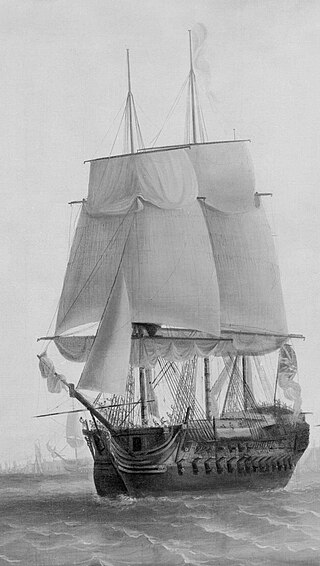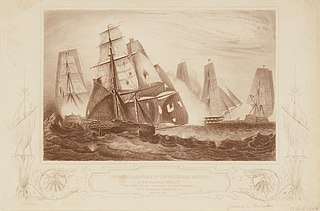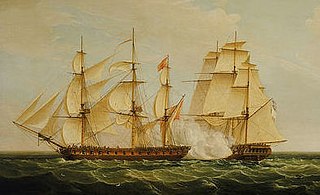
The Battle of Ushant took place on 27 July 1778, and was fought during the American Revolutionary War between French and British fleets 100 miles (160 km) west of Ushant, an island at the mouth of the English Channel off the westernmost point of France. "Ushant" is the anglicised pronunciation of "Ouessant".

Courageux was a 74-gun ship of the line of the French Navy, launched in 1753. She was captured by the Royal Navy in 1761 and taken into service as HMS Courageux. In 1778 she joined the Channel Fleet, and she was later part of the squadron commanded by Commodore Charles Fielding that controversially captured a Dutch convoy on 31 December 1779, in what became known as the Affair of Fielding and Bylandt. On 4 January 1781, Courageux recaptured Minerva in a close-range action west of Ushant that lasted more than an hour. That April, Courageux joined the convoy under George Darby which successfully relieved the Great Siege of Gibraltar.

HMS Latona was a 36-gun, fifth-rate frigate of the Royal Navy that served during the American Revolutionary War, the French Revolutionary Wars, and the Napoleonic Wars. Shortly after her launch in 1781, she participated in the Battle of Dogger Bank against a Dutch squadron in the North Sea. In September 1782, Latona took part in the relief of Gibraltar and was the first ship in the convoy to pass through the Straits, when Richard Howe sent her ahead, to spy on the condition of the Franco-Spanish fleet in Algeciras Bay.

Surveillante was an Iphigénie-class 32-gun frigate of the French Navy. She took part in the Naval operations in the American Revolutionary War, where she became famous for her battle with HMS Quebec; in 1783, she brought the news that the war was over to America. She later took part in the French Revolutionary Wars, and was eventually scuttled during the Expédition d'Irlande after sustaining severe damage in a storm. The wreck was found in 1979 and is now a memorial.
Sixteen ships of the Royal Navy have borne the name HMS Alert, while another was planned:

HMS Rippon was a 60-gun fourth rate ship of the line of the Royal Navy, designed by Sir Joseph Allin and built by Israel Pownoll at Woolwich Dockyard to the draught specified by the 1745 Establishment as amended in 1752, and launched on 20 January 1758.
HMS Antigua was a French frigate launched in 1779. She became a privateer that the British captured in 1804. She served the Royal Navy as a prison ship from 1804 to 1816, when she was broken up.

The action of 13 January 1797 was a minor naval battle fought between a French ship of the line and two British frigates off the coast of Brittany during the French Revolutionary Wars. During the action the frigates outmanoeuvred the much larger French vessel and drove it onto shore in heavy seas, resulting in the deaths of between 400 and 1,000 of the 1,300 persons aboard. One of the British frigates was also lost in the engagement with six sailors drowned after running onto a sandbank while failing to escape a lee shore.

The Junon was a 32-gun Charmante class frigate of the French Navy

Troude's expedition to the Caribbean was a naval operation by a French force under Commodore Amable-Gilles Troude during the Napoleonic Wars. The French squadron departed from Lorient in February 1809 in an attempt to reach and resupply the island colony of Martinique in the Caribbean Sea, then under invasion from a British expeditionary force. The force arrived much too late to affect the outcome of the successful invasion and took shelter from a British squadron in the Îles des Saintes, where they were blockaded by part of the British invasion fleet, led by Vice-Admiral Sir Alexander Cochrane. Two weeks after the French ships arrived, British troops invaded and captured the Saintes, constructing mortar batteries to bombard the French squadron. With his position unsustainable, Commodore Troude decided to break out.

The action of 10 February 1809 was a minor naval engagement of the Napoleonic Wars, in which a British Royal Navy squadron chased and captured the French frigate Junon in the Caribbean Sea. Junon was on a mission to carry trade goods from the Îles des Saintes near Guadeloupe back to France and was part of a succession of French warships sent during 1808 and the early months of 1809 in an effort to break the British blockade of the French Caribbean, which was destroying the economies and morale of the islands. Having landed supplies, Junon's return cargo was intended to improve the economic situation on Guadeloupe with much needed oceanic trade.

Roquebert's expedition to the Caribbean was an unsuccessful operation by a French naval squadron to transport supplies to Guadeloupe in December 1809 at the height of the Napoleonic Wars. Over the previous year, British Royal Navy squadrons had isolated and defeated the French Caribbean colonies one by one, until by the autumn Guadeloupe was the only colony remaining in French hands. Cut off from the rest of the world by British blockade squadrons that intercepted all ships coming to or from the island, Guadeloupe was in a desperate situation, facing economic collapse, food shortages and social upheaval, as well as the impending threat of British invasion. In an effort to reinforce and resupply the colony, the French government sent four vessels to the West Indies in November 1809 under Commodore François Roquebert. Two of the ships were 20-gun flûtes carrying supplies and troops. The two others were 40-gun frigates, ordered to protect the storeships on their journey from the British forces operating off both the French and Guadeloupe coasts.

Iphigénie was a 32-gun Iphigénie-class frigate of the French Navy, and the lead ship of her class. She was briefly in British hands after the Anglo-Spanish capture of Toulon in August 1793 but the French recaptured her December. The Spanish captured her in 1795 and her subsequent fate is unknown.

HMS Fox was a 28-gun Enterprise-class sixth-rate frigate of the Royal Navy. Fox was first commissioned in October 1775 under the command of Captain Patrick Fotheringham. The Americans captured her in June 1777, only to have the British recapture her about a month later. The French then captured her a little less than a year after that, only to lose her to grounding in 1779, some six months later.

HMS Lizard was a 28-gun Coventry-class sixth-rate frigate of the Royal Navy, in service from 1757 to 1828. Named after the Lizard, a peninsula in southern Cornwall, she was a broad-beamed and sturdy vessel designed for lengthy periods at sea. Her crewing complement was 200 and, when fully equipped, she was armed with 24 nine-pounder cannons, supported by four three-pounders and twelve 1⁄2-pounder swivel guns. Despite her sturdy build, she was plagued with maintenance problems and had to be repeatedly removed from service for repair.
Créole was a 40-gun frigate of the French Navy, a one-off design by Jacques-Augustin Lamothe. The French Navy loaned her to a privateer in 1797. Later, she served in the Brest squadron, took part in Ganteaume's expeditions of 1801 to Egypt, and was involved in the French acquisition of Santo Domingo and briefly detained Toussaint Louverture before he was brought to France. The 74-gun ships HMS Vanguard and HMS Cumberland captured her in Santo Domingo on 30 June 1803. The Royal Navy took her into service but she foundered soon afterwards during an attempt to sail to Britain; her crew were rescued.

HMS Ceres was an 18-gun sloop launched in 1777 for the British Royal Navy that the French captured in December 1778 off Saint Lucia. The French Navy took her into service as Cérès. The British recaptured her in 1782 and renamed her HMS Raven, only to have the French recapture her again early in 1783. The French returned her name to Cérès, and she then served in the French Navy until sold at Brest in 1791.

HMS Pearl was a fifth-rate, 32-gun British Royal Navy frigate of the Niger-class. Launched at Chatham Dockyard in 1762, she served in British North America until January 1773, when she sailed to England for repairs. Returning to North America in March 1776, to fight in the American Revolutionary War, Pearl escorted the transports which landed troops in Kip's Bay that September. Much of the following year was spent on the Delaware River where she took part in the Battle of Red Bank in October. Towards the end of 1777, Pearl joined Vice-Admiral Richard Howe's fleet in Narragansett Bay and was still there when the French fleet arrived and began an attack on British positions. Both fleets were forced to retire due to bad weather and the action was inconclusive. Pearl was then despatched to keep an eye on the French fleet, which had been driven into Boston.
The Loire-class flûte was a French Navy class of two 20-gun flûtes that Louis, Antoine, and Marhurin Crucy, Basse Indre, built to a design by François-Louis Etesse, and under a contract dated 5 November 1802.
HMS Fortune was a British 14-gun sloop launched in 1778 that the French captured in April 1780. She then served with the French navy under the same name.














